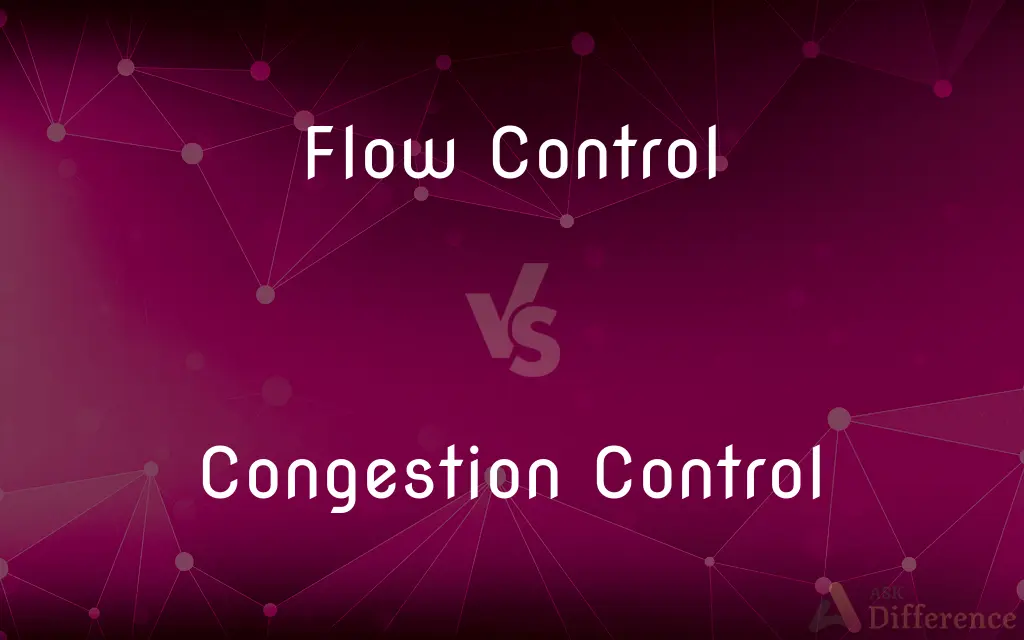Flow Control vs. Congestion Control — What's the Difference?
By Tayyaba Rehman & Urooj Arif — Published on January 30, 2024
Flow Control manages data transfer between devices to prevent data loss, while Congestion Control regulates data flow to avoid network congestion.

Difference Between Flow Control and Congestion Control
Table of Contents
ADVERTISEMENT
Key Differences
Flow Control and Congestion Control are both mechanisms in computer networking, but they serve different purposes. Flow Control is concerned with the pace at which data is transmitted between a sender and receiver to ensure that the receiver's buffer doesn’t overflow. In contrast, Congestion Control is implemented network-wide to prevent too much data from being injected into the network, which can lead to a decrease in network quality due to overloaded routers or links.
In Flow Control, the focus is on a one-to-one communication link between devices. It ensures that a sender does not overwhelm a receiver with data faster than it can process or store it. This is often achieved through techniques like windowing or stop-and-wait protocols. Congestion Control, on the other hand, deals with the collective behavior of all devices in a network. It aims to prevent network-wide problems caused by too many packets being in the network simultaneously, which can lead to packet loss and delays.
Flow Control operates at a micro level, managing the data flow between individual devices in a network. It is a necessary part of reliable data transfer, especially in connections where the sender might be capable of sending data much faster than the receiver can accept it. Congestion Control, conversely, is a macro-level strategy. It is crucial in shared networks like the Internet, where data from multiple sources converge on network paths and routers.
Implementation of Flow Control is typically seen within the protocols of the transport layer of the OSI model, such as TCP (Transmission Control Protocol). It is more about the capacity of the receiving end of the communication. Congestion Control is a broader aspect and is often implemented in both network and transport layers. It addresses issues that arise when too many packets are vying for transmission resources.
Flow Control is often seen as a reactive mechanism, adjusting to the current state of the receiver. For instance, if the receiver's buffer is full, it signals the sender to slow down. Congestion Control is both proactive and reactive, aiming to anticipate congestion before it becomes severe and reacting to current congestion levels by reducing the flow of data.
ADVERTISEMENT
Comparison Chart
Objective
Prevent data overflow at the receiver.
Avoid network overload and packet loss.
Scope
Device-to-device communication.
Network-wide management.
Layer Implementation
Primarily in the Transport layer.
Transport and Network layers.
Mechanisms
Windowing, stop-and-wait protocols.
Packet dropping, bandwidth throttling.
Response to Network Conditions
Reactive to receiver’s capacity.
Proactive and reactive to network congestion.
Compare with Definitions
Flow Control
Involves managing the volume of data packets to match the processing capability of the receiving device.
Flow control in a file transfer ensures the data is sent at a rate that the receiver can handle.
Congestion Control
Congestion Control aims to minimize network traffic congestion to ensure efficient data transmission.
To prevent congestion, the network algorithm reduced the data transmission rate during peak hours.
Flow Control
It dynamically adjusts the rate of data flow between two networked devices.
The flow control protocol paused data transmission when the receiver’s buffer was full.
Congestion Control
It regulates the amount of data entering the network to prevent overload.
Congestion control mechanisms kicked in when heavy traffic threatened network stability.
Flow Control
Flow Control ensures efficient and reliable data transmission between sender and receiver.
In TCP, flow control adjusts the rate of data flow to match the receiver's buffer capacity.
Congestion Control
Congestion Control ensures fair distribution of network resources among users.
The congestion control protocol ensured equal bandwidth allocation to prevent network bottlenecks.
Flow Control
It balances data transmission speed to avoid buffer overflow in the receiver.
Flow control mechanisms prevent a high-speed sender from overwhelming a slow receiver.
Congestion Control
It manages network traffic to optimize performance and avoid delays.
During network congestion, control measures were employed to prioritize essential data packets.
Flow Control
Flow Control maintains a smooth communication channel by adjusting data flow.
Flow control techniques adjust sending intervals to align with the receiver’s processing speed.
Congestion Control
Involves strategies to manage network capacity and avoid packet loss due to overload.
Congestion control algorithms dynamically adjusted the flow of packets during high-traffic periods.
Common Curiosities
How does Congestion Control differ in its objective from Flow Control?
Congestion Control aims to prevent network-wide overload and ensure efficient data transmission across the entire network.
What are common techniques used in Flow Control?
Techniques like windowing and stop-and-wait protocols are commonly used in Flow Control.
How does Congestion Control react to changing network conditions?
Congestion Control uses proactive and reactive strategies to manage network traffic and prevent congestion.
What layers of the OSI model are involved in Congestion Control?
Congestion Control involves both the Transport and Network layers of the OSI model.
What is the primary goal of Flow Control?
To manage data transfer between sender and receiver, preventing data loss or overflow at the receiver.
Can Flow Control and Congestion Control operate independently?
While they can function independently, both are essential for optimal network performance and often work in conjunction.
Are there any negative impacts of overly aggressive Congestion Control?
Overly aggressive Congestion Control can lead to underutilization of network capacity and reduced throughput.
Is Flow Control applicable in all types of networks?
Flow Control is essential in both wired and wireless networks for efficient, reliable data transmission.
How does Flow Control benefit data communication?
It ensures data integrity and efficient utilization of the receiver’s processing and storage capacities.
Can Congestion Control solve all network traffic issues?
While it helps manage traffic and prevent congestion, it’s not a complete solution for all network issues like bandwidth limitations.
Does Flow Control require cooperation from both sender and receiver?
Yes, effective Flow Control requires both sender and receiver to communicate and adjust data transmission rates accordingly.
How do Flow Control mechanisms detect a receiver's capacity?
They use feedback from the receiver, such as acknowledgment packets, to gauge its capacity and adjust data flow.
Can network protocols automatically adjust to optimize both Flow Control and Congestion Control?
Yes, modern network protocols often have built-in mechanisms to automatically optimize both for efficient data transmission.
What happens if Flow Control is not implemented in a network?
Without Flow Control, data can be sent at a rate that exceeds the receiver's capacity, leading to data loss and inefficiency.
Is Congestion Control more relevant in large or small networks?
Congestion Control is crucial in large networks like the Internet, where multiple data flows converge.
Share Your Discovery

Previous Comparison
Renaissance Worldview vs. Enlightenment Worldview
Next Comparison
Kanji vs. KatakanaAuthor Spotlight
Written by
Tayyaba RehmanTayyaba Rehman is a distinguished writer, currently serving as a primary contributor to askdifference.com. As a researcher in semantics and etymology, Tayyaba's passion for the complexity of languages and their distinctions has found a perfect home on the platform. Tayyaba delves into the intricacies of language, distinguishing between commonly confused words and phrases, thereby providing clarity for readers worldwide.
Co-written by
Urooj ArifUrooj is a skilled content writer at Ask Difference, known for her exceptional ability to simplify complex topics into engaging and informative content. With a passion for research and a flair for clear, concise writing, she consistently delivers articles that resonate with our diverse audience.
















































